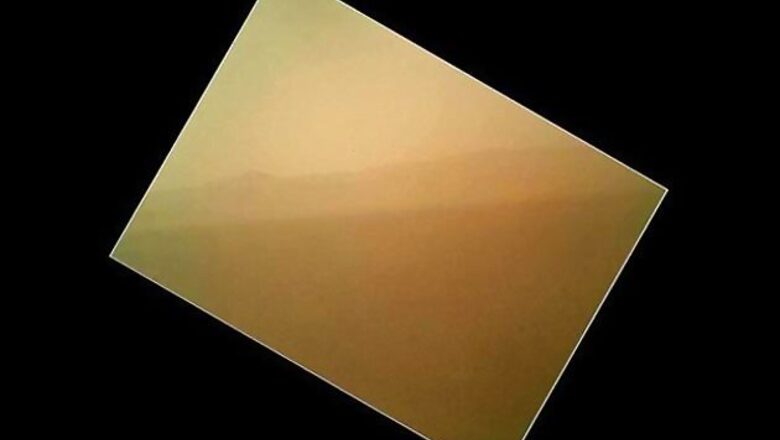
views
Pasadena: NASA's Curiosity rover has beamed back its first color photo from the ancient crater where it landed on Mars and a video showing the last 2 1/2 minutes of its white-knuckle dive through the Martian atmosphere, a sneak peek of a spacecraft landing on another world.
The picture released on Tuesday revealed a rust-tinged, pebbly landscape and the crater rim off in the distance. The six-wheel rover snapped the photo on the first day on the surface after touching down on Mars Sunday night. It took the shot with a camera at the end of its robotic arm, which remained stowed.
As Curiosity plunged through the atmosphere, a video camera captured the final moments. Nearly 300 low-quality thumbnails were sent back on Monday, which NASA processed into a short video.
As the video rolled on a big screen, scientists and engineers at the NASA Jet Propulsion Laboratory let out "oohs" and "aahs." The recording began with the protective heat shield falling away and ended with dust being kicked up as the rover was lowered by cables inside Gale Crater.
It was a preview of a spacecraft touchdown on another planet, since it'll take some time before high-resolution frames are transmitted, depending on other priorities.
The full video "will just be exquisite," said Michael Malin, the chief scientist of the instrument.
Since parking itself inside a giant crater, Curiosity has steadily streamed home a flurry of photos. The first were grainy, black-and-white images of its wheel, Martian gravel and a mountain at sunset. The landscape in the color shot looked fuzzy because the camera was coated with dust as the rover touched the ground.
Curiosity, a roving laboratory the size of a compact car, landed right on target late Sunday after an eight-month, 352-million-mile journey. It parked its six wheels about four miles from its ultimate science destination - Mount Sharp, rising from the floor of Gale Crater near the equator.
Extraordinary efforts were needed for the landing because the rover weighs one ton, and the thin Martian atmosphere offers little friction to slow down a spacecraft. Curiosity had to go from 13,000 mph to zero in seven minutes, relying on a heat shield, parachute and rockets to slow down. In the final few seconds, cables lowered it to the ground at 2 mph.
At the end of what NASA called "seven minutes of terror," the vehicle settled into place almost perfectly flat in the crater it was aiming for.
"We have ended one phase of the mission much to our enjoyment," mission manager Mike Watkins said. "But another part has just begun."
The nuclear-powered Curiosity will dig into the Martian surface to analyze what's there and hunt for some of the molecular building blocks of life, including carbon.
It won't start moving for a couple of weeks, because all the systems on the $2.5 billion rover have to be checked out. As it goes through its health checkups this week, it was expected to send back more stunning views of its surroundings.
But first NASA had to use tiny cameras designed to spot hazards in front of Curiosity's wheels. So early images of gravel and shadows abounded. The pictures were fuzzy, but scientists were delighted.
The photos show "a new Mars we have never seen before," Watkins said. "So every one of those pictures is the most beautiful picture I have ever seen."
In one of the photos from the close-to-the-ground hazard cameras, if you squinted and looked the right way, you could see "a silhouette of Mount Sharp in the setting sun," said an excited John Grotzinger, chief mission scientist from the California Institute of Technology.
A high-resolution camera on the orbiting 7-year-old Mars Reconnaissance Orbiter, flying 211 miles directly above the plummeting Curiosity, snapped a photo of the rover dangling from its parachute about a minute from touchdown. The parachute's design can be made out in the photo.
"It's just mind-boggling to me," said Miguel San Martin, chief engineer for the landing team.
Curiosity is the heaviest piece of machinery NASA has landed on Mars, and the success gave the space agency confidence that it can unload equipment that astronauts may need in a future manned trip to the red planet.
The landing technique was hatched in 1999 after devastating back-to-back Mars spacecraft losses. Back then, engineers had no clue how to land super-heavy spacecraft. They brainstormed different possibilities, consulting Apollo-era engineers and pilots of heavy-lift helicopters.
"I think its engineering at its finest. What engineers do is they make the impossible possible," said former NASA chief technologist Bobby Braun. "This thing is elegant. People say it looks crazy. Each system was designed for a very specific function."
Because of budget constraints, NASA canceled its joint US-European missions to Mars, scheduled for 2016 and 2018.
"When's the next lander on Mars? The answer to that is nobody knows," Bolden said in a recent interview with The Associated Press.
But if Curiosity finds something interesting, he said, it could spur the public and Congress to provide more money for more Martian exploration. No matter what, he said, Curiosity's mission will help NASA as it tries to send astronauts to Mars by the mid-2030s.

















Comments
0 comment